
Concept explainers
Interpretation:
The structural formulas for the given compounds are to be provided.
Concept Introduction:
In Fischer projection formula, the horizontal and vertical line represents the bonds that are present above and below the plane, respectively.
The verticals bonds are represented as dashed wedge and horizontal bonds as dark wedge.
Answer to Problem 26P
Solution:
a) The structural formula of
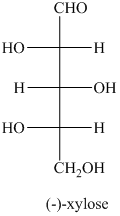
b) The structural formula for the xylitol is
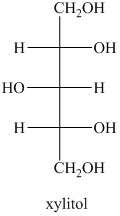
c) The structural formula of
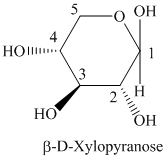
d) The structural formula of
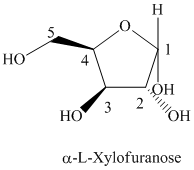
e) The structure of
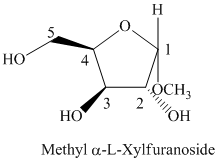
f) The Fischer projection formula for the given compound is shown below.
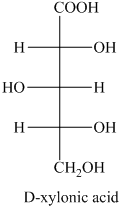
g) The structure of the given compound is shown below.
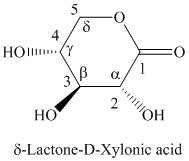
h) The structure of the given compound is shown below.
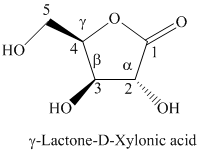
i) The Fischer projection formula for the given compound is shown below.
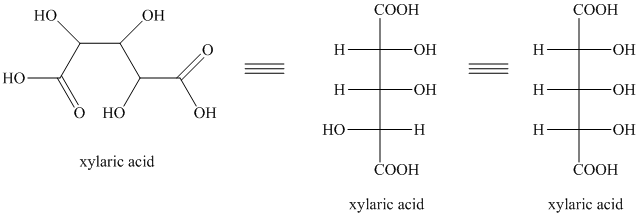
Explanation of Solution
a) The given structure of
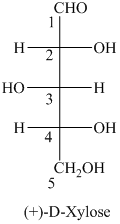
In,
L and D indicate the absolute configuration of a compound. If hydroxy group attached with chiral centre is to the right side and present on the bottom, then the carbohydrate is in D form but if hydroxy group is present to the left side then the carbohydrate is in L-form.
The name of the given compound is
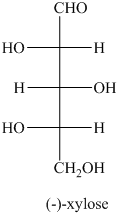
b) The given compound is xylitol.
The alcohol derivative of xylose is xylitol in which the reduction of

c) The given compound is
Sugar molecule that has six-membered-ring is known as pyranose and sugar molecule that has five-membered-ring is called furanose.
The given compound is formed when

Thus, the structural formula of

d) The given compound is
L and D indicate the absolute configuration of a compound. If hydroxy group attached with chiral centre is to the right side and present on the bottom, then the carbohydrate is in D form but if hydroxy group is present to the left side then the carbohydrate is in L-form.
The given compound is formed when

Thus, the structural formula of
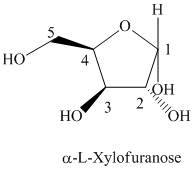
e) The given compound is
The given compound is formed when hydroxyl group is replaced by methoxy group as shown below.

Thus, the structure of
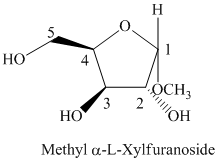
f) The given compound is
The oxidation of
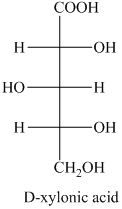
g) The given compound is
Lactones are class of organic compound which contain
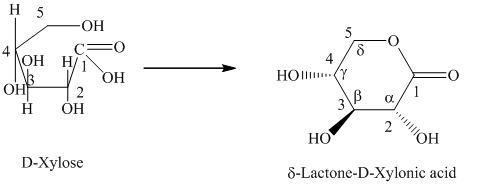
Thus, the structure of the given compound is shown below.

h) The given compound is
Lactones are class of organic compound which contain
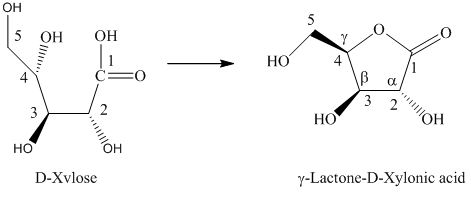
Thus, the structure of the given compound is shown below.
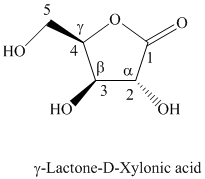
i) The given compound is Xylaric acid.
The oxidation of

Want to see more full solutions like this?
Chapter 24 Solutions
ORGANIC CHEMISTRY (LL)-W/SOLN.>CUSTOM<
- Part 9 of 9 Consider the products for the reaction. Identify the major and minor products. HO Cl The E stereoisomer is the major product and the Z stereoisomer is the minor product ▼ S major product minor productarrow_forwardConsider the reactants below. Answer the following questions about the reaction mechanism and products. HO Clarrow_forwardjulietteyep@gmail.com X YSCU Grades for Juliette L Turner: Orc X 199 A ALEKS - Juliette Turner - Modul X A ALEKS - Juliette Turner - Modul x G butane newman projection - Gox + www-awa.aleks.com/alekscgi/x/Isl.exe/10_u-IgNslkr7j8P3jH-IBxzaplnN4HsoQggFsejpgqKoyrQrB2dKVAN-BcZvcye0LYa6eXZ8d4vVr8Nc1GZqko5mtw-d1MkNcNzzwZsLf2Tu9_V817y?10Bw7QYjlb il Scribbr citation APA SCU email Student Portal | Main Ryker-Learning WCU-PHARM D MySCU YSCU Canvas- SCU Module 4: Homework (Ch 9-10) Question 28 of 30 (1 point) | Question Attempt: 1 of Unlimited H₂SO heat OH The mechanism of this reaction involves two carbocation intermediates, A and B. Part 1 of 2 KHSO 4 rearrangement A heat B H₂O 2 OH Draw the structure of A. Check Search #t m Save For Later Juliet Submit Assignm 2025 McGraw Hill LLC. All Rights Reserved. Terms of Use | Privacy Center | Accessarrow_forward
- The electrons flow from the electron-rich atoms of the nucleophile to the electrons poor atoms of the alkyl halide. Identify the electron rich in the nucleophile. Enter the element symbol only, do not include any changes.arrow_forwardHello, I am doing a court case analysis in my Analytical Chemistry course. The case is about a dog napping and my role is prosecution of the defendant. I am tasked in the Area of Expertise in Neutron Activation and Isotopic Analysis. Attached is the following case study reading of my area of expertise! The landscaping stone was not particularly distinctive in its decoration but matched both the color and pattern of the Fluential’s landscaping stone as well as the stone in the back of the recovered vehicle. Further analysis of the stone was done using a technique called instrumental neutron activation analysis. (Proceed to Neutron Activation data) Photo Notes: Landscaping stone recovered in vehicle. Stone at Fluential’s home is similar inappearance. Finally, the white paint on the brick was analyzed using stable isotope analysis. The brick recovered at the scene had smeared white paint on it. A couple of pieces of brick in the back of the car had white paint on them. They…arrow_forwardCite the stability criteria of an enamine..arrow_forward
- What would you expect to be the major product obtained from the following reaction? Please explain what is happening here. Provide a detailed explanation and a drawing showing how the reaction occurs. The correct answer to this question is V.arrow_forwardPlease answer the question for the reactions, thank youarrow_forwardWhat is the product of the following reaction? Please include a detailed explanation of what is happening in this question. Include a drawing showing how the reagent is reacting with the catalyst to produce the correct product. The correct answer is IV.arrow_forward
 Introduction to General, Organic and BiochemistryChemistryISBN:9781285869759Author:Frederick A. Bettelheim, William H. Brown, Mary K. Campbell, Shawn O. Farrell, Omar TorresPublisher:Cengage Learning
Introduction to General, Organic and BiochemistryChemistryISBN:9781285869759Author:Frederick A. Bettelheim, William H. Brown, Mary K. Campbell, Shawn O. Farrell, Omar TorresPublisher:Cengage Learning Organic ChemistryChemistryISBN:9781305580350Author:William H. Brown, Brent L. Iverson, Eric Anslyn, Christopher S. FootePublisher:Cengage Learning
Organic ChemistryChemistryISBN:9781305580350Author:William H. Brown, Brent L. Iverson, Eric Anslyn, Christopher S. FootePublisher:Cengage Learning Chemistry for Today: General, Organic, and Bioche...ChemistryISBN:9781305960060Author:Spencer L. Seager, Michael R. Slabaugh, Maren S. HansenPublisher:Cengage Learning
Chemistry for Today: General, Organic, and Bioche...ChemistryISBN:9781305960060Author:Spencer L. Seager, Michael R. Slabaugh, Maren S. HansenPublisher:Cengage Learning



